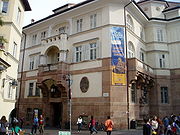
South Tyrol Museum of Archaeology
Encyclopedia

Museum
A museum is an institution that cares for a collection of artifacts and other objects of scientific, artistic, cultural, or historical importance and makes them available for public viewing through exhibits that may be permanent or temporary. Most large museums are located in major cities...
in the city of Bolzano, the capital of South Tyrol
South Tyrol
South Tyrol , also known by its Italian name Alto Adige, is an autonomous province in northern Italy. It is one of the two autonomous provinces that make up the autonomous region of Trentino-Alto Adige/Südtirol. The province has an area of and a total population of more than 500,000 inhabitants...
, northern Italy
Italy
Italy , officially the Italian Republic languages]] under the European Charter for Regional or Minority Languages. In each of these, Italy's official name is as follows:;;;;;;;;), is a unitary parliamentary republic in South-Central Europe. To the north it borders France, Switzerland, Austria and...
. It is the home of the preserved body of Ötzi the Iceman
Ötzi the Iceman
Ötzi the Iceman , Similaun Man, and Man from Hauslabjoch are modern names for a well-preserved natural mummy of a man who lived about 5,300 years ago. The mummy was found in September 1991 in the Ötztal Alps, near Hauslabjoch on the border between Austria and Italy. The nickname comes from the...
.
History
The museum was specifically established in 1998 to house "Ötzi", a well-preserved natural mummyMummy
A mummy is a body, human or animal, whose skin and organs have been preserved by either intentional or incidental exposure to chemicals, extreme coldness , very low humidity, or lack of air when bodies are submerged in bogs, so that the recovered body will not decay further if kept in cool and dry...
of a man from about 3300 BC
34th century BC
-Events:* Life and death of Ötzi the Iceman, a mummy discovered in the Austrian/Italian Alps in 1991.* Plough is first used.-Cultures:*Funnelbeaker culture*Stage IIIa2 of the Naqada culture in Egypt ....
(53 centuries ago). This is the world's oldest natural human mummy, a wet mummy, as opposed to mummies preserved by dry conditions in a desert environment.It has offered an unprecedented view of Chalcolithic (Copper Age
Copper Age
The Chalcolithic |stone]]") period or Copper Age, also known as the Eneolithic/Æneolithic , is a phase of the Bronze Age in which the addition of tin to copper to form bronze during smelting remained yet unknown by the metallurgists of the times...
) European culture.
The world's oldest complete copper age axe was found among his extensive equipment which also comprised a rather complex fire lighting kit and a quiver loaded with twelve arrows, only two of which were finished, clothing and a flint knife complete with its sheath.
The body is held in a climate controlled chamber within the museum at a temperature of -6 Celsius and 98% humidity, replicating glacier conditions in which it was found. Along with original finds there are models, reconstructions and multimedia presentations showing Ötzi in the context of the early history of the southern Alpine region.
Converted from a 19th century bank building, the museum covers the history and archaeology of the southern Alpine region from the Palaeolithic and Mesolithic (15,000 B.C.) up to 800 A.D. In 2006 the museum hosted an exhibition on the mummies of the Chachapoyas culture
Chachapoyas culture
The Chachapoyas, also called the Warriors of the Clouds, were an Andean people living in the cloud forests of the Amazonas region of present-day Peru. The Incas conquered their civilization shortly before the arrival of the Spanish in Peru. When the Spanish arrived in Peru in the 16th century, the...
.

